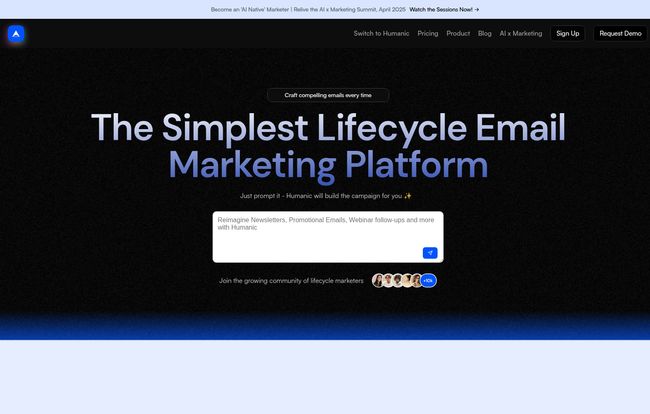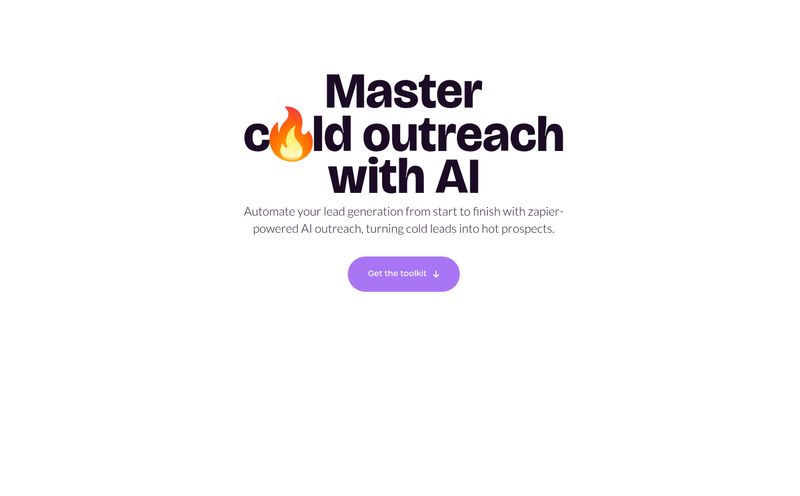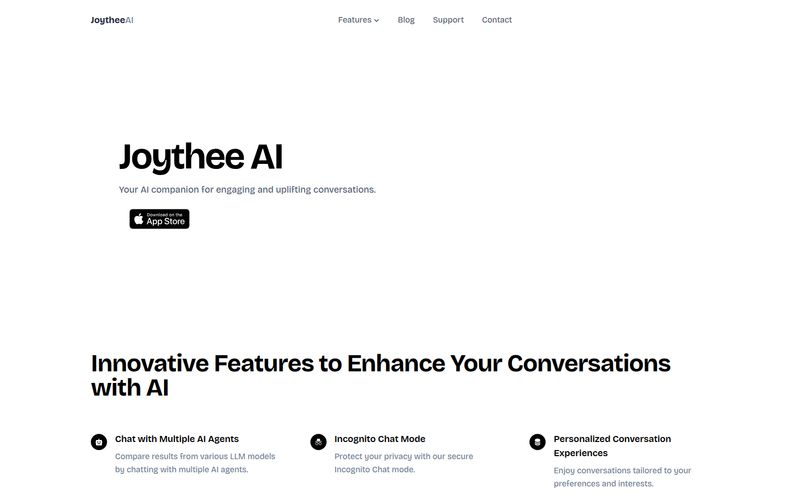If you're in the SaaS world, especially anywhere near product or marketing, you've heard the term 'Product-Led Growth' (PLG) about a million times. It's the holy grail, right? Build a great product, let people try it, and they'll happily upgrade. Simple. Except… it's not. The reality is often a messy tangle of user data, generic onboarding emails, and a huge gap between a 'free user' and a 'paying customer'.
For years, we've been trying to jam the square peg of traditional marketing automation into the round hole of PLG. We track email opens and clicks, but what we really care about is what users are doing (or not doing) inside the app. I’ve spent more hours than I’d like to admit trying to stitch together product analytics with an ESP, usually begging for engineering resources. It's a pain.
So when I stumbled upon a platform called Humanic, my battle-worn marketing senses started tingling. They call themselves a 'PLG CRM' and an 'Agentic Email Marketing Platform'. Lots of buzzwords, I know. But the promise behind them is what caught my eye: a tool designed specifically to bridge that gap between product usage and marketing communication. Could this actually be it?
So, What Exactly is a PLG CRM?
Before we go further, lets just clear this up. A traditional CRM (think HubSpot, Salesforce) is great at tracking sales-led interactions—calls, demos, deals. An MQL (Marketing-Qualified Lead) is its bread and butter. But in a PLG model, the most important signals aren't coming from a salesperson's notes; they're coming from the product itself.
A PLG CRM flips the script. Its main job is to slurp up all that rich product usage data and make sense of it. It helps you identify your PQLs—Product-Qualified Leads. These are the folks who've hit key activation milestones within your app. They've discovered its value. They are your best shot at an upgrade. A PLG CRM is less about tracking deals and more about understanding user behavior to nudge them toward that 'aha!' moment and, eventually, their credit card.

Visit Humanic
Enter Humanic: More Than Just Another Email Tool
This is where Humanic steps onto the stage. It's not just another platform to send your weekly newsletter. It’s designed to be the brain connecting your product's data to your email marketing. The big, headline feature for me? It does this without needing a dedicated data warehouse. Anyone who has ever been quoted for a Snowflake or BigQuery implementation knows that this is huge. It removes a massive technical and financial barrier that stops most marketing teams in their tracks.
Humanic plugs into your product and starts analyzing user actions to help you build smarter, more effective lifecycle email campaigns. It’s about sending the right message to the right user at the exact right time, based on what they're doing in your app. Not based on whether they downloaded a whitepaper three months ago.
Uncovering Your “Dark Pipeline”
I love this term. The 'dark pipeline' is all that potential revenue hiding in your user base. It's the teams who are using your free plan extensively but haven't triggered a conversation with sales. It's the power user who has invited five colleagues but is still on a personal plan. Traditional tools are completely blind to this.
Humanic claims to shine a light on this pipeline. By tracking product usage, it can help you spot these high-potential accounts and individuals before they even think about upgrading. You can then create specific campaigns to engage them. This is proactive, not reactive, marketing. It's the difference between waiting for a fish to bite and knowing exactly where the fish are schooling.
AI-Powered Micro-Cohorts Are a Game-Changer
Okay, “AI-powered” is another term that gets thrown around like confetti these days. But in this context, it actually makes sense. Manually creating user segments is tedious and often based on guesswork. 'Let's email everyone who signed up in the last 30 days but hasn't used Feature X.' Sound familiar?
Humanic uses its AI to create what it calls 'micro-cohorts'. It automatically groups users based on subtle patterns in their behavior. Maybe it finds a group of 50 users from fintech startups who all use one specific feature on Tuesday mornings. Good luck finding that segment on your own. Once it identifies these cohorts, its 'agentic' side kicks in, helping you craft and automate tailored email content just for them. It's a level of personalization that's been practically impossible to achieve at scale. Until now, maybe.
My Take on The Good Stuff
After looking through what Humanic offers, a few things really stand out from a practitioner's point of view.
- No Data Warehouse Needed: I have to say it again because it matters that much. This democratizes powerful data capabilities for teams that don't have a dedicated data engineering department. It's a massive win.
- Focus on PQLs, Not MQLs: It fundamentally gets the PLG model. It reorients your thinking around product-based signals, which are far more indicative of purchase intent in a self-serve world.
- Automation that Saves Sanity: The idea of an AI agent identifying cohorts and teeing up campaigns is… well, it's the dream. It frees up marketers to think about strategy and messaging, not just endless data queries and list-building. One testimonial from Jonathan Sousa at Loom mentions it's the best tool for 'finding signal from noise,' and that perfectly captures the value here.
Let's Be Real: The Potential Hurdles
No tool is perfect, and it's my job to be a bit of a skeptic. Based on my experience with similar platforms, here's where I see potential bumps in the road.
First, there's always an initial setup. While it might not require a data warehouse, you still need to get your product data flowing into Humanic. Depending on your tech stack, this could be a quick integration or a more involved project. Second, its greatest strength is also a dependency: its effectiveness is tied directly to the quality and richness of your product data. If your event tracking is a mess, Humanic won't have much to work with. GIGO—garbage in, garbage out—still applies. Finally, there's likely a learning curve. It's a new way of thinking for many marketers, moving from campaign-centric to user-behavior-centric. That shift takes time and effort.
What's the Damage? A Look at Humanic's Pricing
This is often the million-dollar question. And here’s some fantastic news. The Humanic website prominently states, "Get Started on our new AI x Email Platform for Free!"
A free entry point is incredible for a tool this powerful. It means you can actually hook it up, kick the tires, and see if it provides real value before committing any budget. For a startup or a team with a limited budget, this is a no-brainer. I'm sure they have paid tiers for larger scale and more advanced features, and you'd need to contact them or check their pricing page for that specific info, but the ability to start for $0 is a huge plus in my book.
Who is Humanic Really For?
So, who should be dropping everything and signing up? In my opinion, Humanic is tailor-made for a few specific groups:
- SaaS Companies with a PLG Motion: This is the sweet spot. If your growth model depends on users signing up for a free trial or freemium plan, this tool speaks your language. I see logos like Loom, Chargebee, and Mozilla on their site, which confirms this is their core audience.
- Marketing & Growth Teams: Specifically, those who feel handcuffed by a lack of data or engineering support. If you know you should be doing more with personalization but don't have the tools, this is for you.
- Founders & Product Managers: Anyone who wants to close the loop between how the product is used and how it's marketed. It helps turn product insights into revenue-generating actions.
If you're still running a purely sales-led motion, this might be overkill. But for the growing army of us in the product-led world, Humanic feels less like just another tool and more like a missing piece of the puzzle.
Final Thoughts: Cutting Through the Noise
Look, the martech space is incredibly crowded. It's noisy. Every week there's a new 'AI-powered solution' that promises to revolutionize everything. Most of them are just hype. But Humanic feels different. It's not trying to be everything to everyone. It’s focused on solving a very specific, very painful problem for a very specific (and growing) type of business.
By connecting product usage directly to email marketing and automating the heavy lifting of segmentation, it gives PLG companies a lever they've been missing. It's a way to finally act on all that rich user data we've been collecting. If you're tired of guessing and want to start having data-driven conversations with your users to guide them from activation to adoption, Humanic is absolutely worth a look. The fact that you can start for free makes it one of the more interesting opportunities I've seen this year.
Frequently Asked Questions (FAQ)
- 1. In simple terms, what is Humanic?
- Humanic is a PLG CRM and email marketing platform. It analyzes how users interact with your product and helps you automatically send them super-targeted emails to increase activation, adoption, and ultimately, revenue.
- 2. How is Humanic different from something like Mailchimp or HubSpot?
- While HubSpot and Mailchimp are great general-purpose email platforms, Humanic is built specifically for Product-Led Growth (PLG) companies. Its core strength is using your actual product usage data for segmentation and automation, not just marketing data like email opens or website visits.
- 3. Do I need a data engineer or a data warehouse to use Humanic?
- No! This is one of its biggest selling points. Humanic is designed to work without needing a complex and expensive data warehouse, making it accessible for marketing teams without deep technical resources.
- 4. What is a PQL and why does it matter?
- A PQL stands for Product-Qualified Lead. Unlike a Marketing-Qualified Lead (MQL) who might have just downloaded an ebook, a PQL is a user who has taken specific, high-value actions inside your product. They've experienced its value firsthand, making them much more likely to convert to a paying customer.
- 5. Is Humanic really free to use?
- Humanic offers a free starting plan, which allows you to get set up and begin using the platform without a financial commitment. They likely offer paid tiers with more advanced features and higher usage limits for scaling companies.
Reference and Sources
- Humanic Official Website: https://www.humanic.ai/



